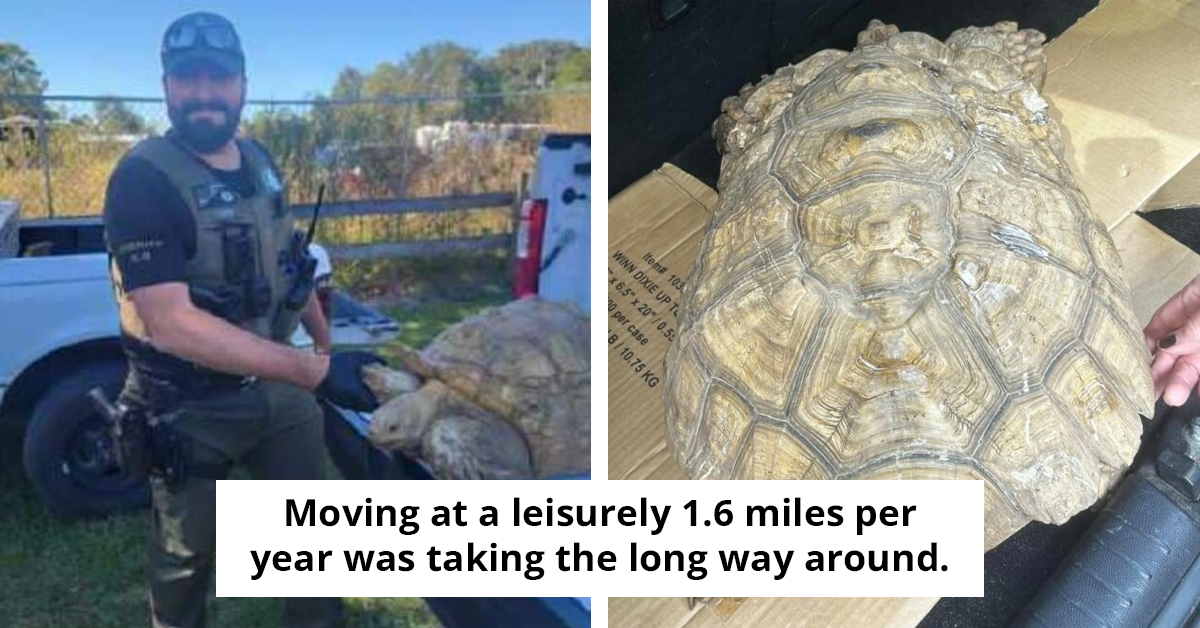Redditor Takes Their Dog to Off-Leash Dog Park and Gets Confused by One Mom’s Reaction When Their Dog Approached Her Baby
If you live in the country or in a suburban area, exercising your dog is not a problem, but people in densely populated areas don’t have much choice. They are limited to dog parks.
These parks are the only places where you can let your dog run free and burn off that excessive energy. However, there is a problem.
Parents also don’t have many places to take their small kids to run and enjoy grass and trees. This makes parents and pet owners contend for the same spaces.
This situation often leads to misunderstandings, especially because some people believe they are more entitled than others. One Redditor shared their problem:
“I have a 7-month-old, 4.5 kg cavoodle puppy. Our regular dog park is being sprayed with pesticides, so today I took my puppy to a new dog park near my house.”
This dog park has a designated off-leash area.
“There was a mom with her baby (approximately 12 months) sitting on the grass at the edge of where all the dogs were playing,” OP continues.
“As usual, when you have friendly dogs that love people: at one point, my dog said hello to the woman and her baby. She did jump up on the mom but only sniffed the baby; she didn't jump. The baby started crying, and the mom got cross with me about my dog's behavior.”
Read this interesting story below:
OP asks:

OP has a 7-month-old small puppy. Since their regular dog park was unavailable, they went to a different dog park.

One mom was sitting on the grass with her 12-month-old baby, and the dog came to them to say hi.
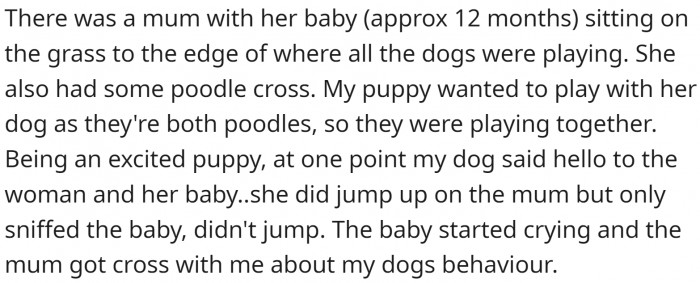
Parental Anxiety and Protective Instincts
The mother's reaction to the dog approaching her baby likely stems from instinctual protective behaviors. According to Dr. Alice Miller, a psychologist specializing in child development, parents often exhibit heightened anxiety regarding their children's safety, especially in unfamiliar settings.
Research shows that such anxiety can trigger immediate fight-or-flight responses, leading to behaviors that might seem disproportionate to the actual threat. This protective instinct is a natural aspect of parenting, but it can sometimes manifest in overly cautious reactions.
Understanding Parental Instincts
The reaction of the mother at the dog park likely stems from a protective instinct, a concept rooted in evolutionary psychology. Research shows that parents are wired to instinctively protect their offspring from perceived threats. In this case, the presence of a dog near her baby could have triggered her protective mechanisms, which can be heightened in new parents. According to studies published in the Journal of Evolutionary Psychology, such instinctual reactions are common and can lead to heightened vigilance in social situations involving children.
This instinct can sometimes manifest in ways that might seem overly cautious or even defensive, particularly in public spaces where unknown factors come into play.
Mom started yelling at OP about how they should control their dog.
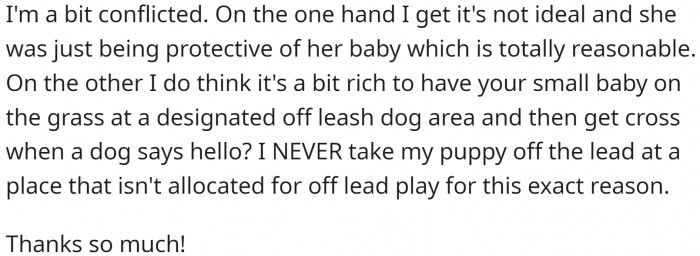
Redditors agree - this mom was asking for trouble.

Pet owners are responsible for their pets, but on the other hand, parents are also responsible for their kids.
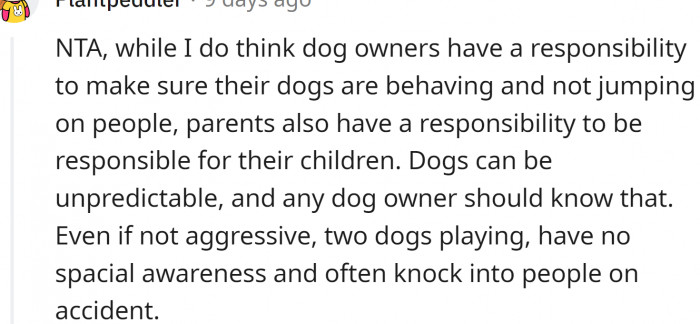
Interestingly, these protective instincts may also reflect the mother's own experiences and fears surrounding parenting. Studies suggest that past traumas or negative experiences can shape how parents respond to potential threats, often leading to heightened vigilance in situations involving their children.
This psychological phenomenon emphasizes the need for empathy and understanding when evaluating parental responses, as they are often rooted in deeper emotional experiences.
From a social psychology perspective, this situation illustrates how context can influence our perceptions and reactions. The presence of a dog, regardless of its behavior, can evoke anxiety in some parents due to cultural narratives surrounding pet safety and hygiene. Research from Yale University indicates that perceived threats can lead individuals to react strongly, often in ways that are disproportionate to the actual risk. This phenomenon can be exacerbated by personal experiences or societal fears regarding animals and children.
Understanding this can help mitigate misunderstandings between pet owners and parents, fostering a more empathetic community dynamic.
That mom was really irresponsible.

Even if there are no dogs near the baby, dogs do their business there. It is not sanitary to let a kid crawl there.

Some Redditors see a bit of OP’s fault here.

Effective Communication Strategies for Parents
To navigate such situations effectively, employing clear communication strategies is essential. Dr. John Gottman's research on relationship dynamics highlights the importance of expressing concerns without escalating tensions. Parents can benefit from discussing their feelings openly, emphasizing the need for safety while also considering the socialization of their children with pets.
For instance, highlighting the positive aspects of dog interactions can help reduce the perceived threat. Establishing boundaries and educating children about safe interactions with animals can also alleviate anxiety and promote understanding.
Effective Communication Strategies
To improve interactions in situations like these, fostering open communication is key. A study from the University of California, Berkeley emphasizes the importance of expressing feelings and intentions clearly to avoid misunderstandings. The dog owner could approach the mother calmly to reassure her about the dog’s behavior and intentions. Such interactions can help alleviate her anxiety and build rapport between the two parties.
Moreover, transparency about pet behavior and training can help demystify potential threats, allowing for a more relaxed atmosphere where both parties feel safe. This approach can promote a sense of community rather than division.
They would never allow their dog to go near a baby - so many things that could go wrong.

OP should work on training their dog.
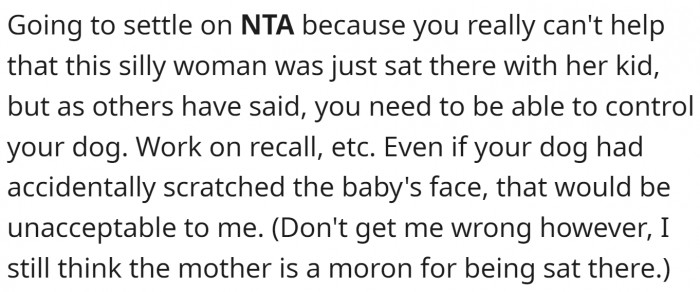
The bottom line is:

Moreover, fostering a positive environment around pets can help mitigate fears. Engaging children in pet care activities can create a sense of responsibility and understanding, allowing them to learn about animal behavior in a controlled manner. Research indicates that children who interact positively with pets tend to develop greater empathy and social skills, enhancing their relational capabilities.
By integrating educational elements into these experiences, parents can help their children cultivate a healthy understanding of animals while addressing their own protective instincts.
Another vital aspect to consider is the role of empathy in these interactions. Empathy can bridge the gap between differing perspectives, allowing individuals to see situations through each other's eyes. Research from the American Psychological Association highlights that empathetic engagement can significantly reduce conflict and foster harmonious relationships. In this case, the dog owner could reflect on the mother's fears and validate her feelings, which can lead to a more productive conversation.
By acknowledging her protective instincts, the owner can foster goodwill and ease any tension, ultimately facilitating a more pleasant experience for everyone involved.
So, what do you think? Who is at fault here?
We agree that this mom didn’t choose well when she looked for a place to spend quality time with her baby. Bringing a small child near a large group of playful dogs…
So much can go wrong there. OP mentioned that this mom also had a dog, so she probably tried to accommodate it too. Either way, all parties here must be more careful.
Mom should choose parks more wisely, and our OP should train his puppy not to jump on people and to obey basic commands. Playful pups don't mean harm, but they can knock a baby over or scratch it...
Building a Community of Understanding
Creating a dog-friendly environment that prioritizes child safety can benefit both pet owners and parents. Engaging local community members to discuss shared values and concerns can lead to collaborative solutions. Initiatives like designated play areas for dogs and children can help alleviate fears and encourage positive interactions. Research shows that community engagement fosters shared responsibility, enhancing the overall experience for everyone.
Encouraging pet owners to undergo training in behavioral management can also help ensure that all dogs are well-behaved and less likely to trigger parental anxiety.
Psychological Analysis
This situation highlights a common tension between pet ownership and parenting, where protective instincts can clash with the social dynamics of public spaces. The mother's reaction, while instinctual, underscores the importance of approaching such situations with empathy. Encouraging understanding can help bridge the gap and foster a more harmonious environment for all.
Analysis generated by AI
Analysis & Alternative Approaches
Ultimately, understanding the psychological factors at play can help foster better interactions between dog owners and parents. By emphasizing empathy and clear communication, both parties can navigate their differences and build a supportive community. Research shows that these efforts lead to safer, more enjoyable experiences in shared spaces, benefiting everyone involved.
Analysis & Alternative Approaches
In conclusion, understanding the psychological dynamics of parental reactions can lead to more constructive interactions in public spaces. Recognizing that protective instincts are often influenced by personal experiences can facilitate empathy and open dialogue.
According to studies in developmental psychology, fostering positive interactions between children and pets can enhance emotional and social development, ultimately benefiting both the parent and child.
